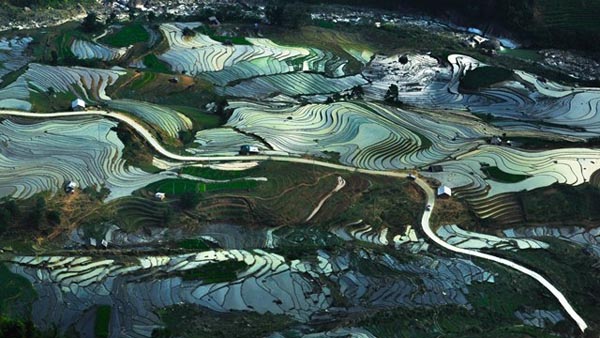



In early summer every year, hamlets in the northwest again fall into "pouring water season."

These
days, when travelling through majestic fields in Sapa, Bat Xat (Lao Cai
Province), Mu Cang Chai (Yen Bai), Hoang Su Phi (Ha Giang), and Bac Yen (Son
La), an incredible sight of terraced fields soaked with water inspires many
visitors to come to the North-west and explore this legendary beauty.

Not
vast in size like the paddy fields in the deltas, terraced fields in the
highlands of the North-west overlap from layer to layer as ladders reaching to
the blue sky.

The
North-west rice fields filled with water until planting, sparkling like a
coloured mural amidst jungles and mountains.

Water
runs from field to field, rolling in the colour of mulch mixed with the
reflected blue sky, creating a spectacular picture. Perhaps, no artist can
colour such vivid and energetic paintings like the north-western farmers.

The
North-western region, in the pouring water season, is one of the unique tourism
products of the northern mountainous region, attracting thousands of domestic and
foreign tourists to visit each year.
.jpg)
The
typical characteristics of the terraced fields are high steep levels and
winding terrain. Farmers mainly utilise natural water sources to cultivate
rice, so making the water run into their fields is an art that requires
talented and industrious efforts.

In
the uplands, farmers only plant a single crop a year. When the first rains of
the summer have fallen, local farmers also start bringing water into their
fields.

Farmers
in the north-western region often dry their fields during May and June. After
that, they pour water into the soil. The water flows from ravines through
bamboo tubes to fill the fields, creating multicoloured paintings: the yellow
of the alluvium, the greenish colour of young rice sprouts freshly sown and the
reflected colour of the blue sky.

When
adequate water has been drawn in, the Mong and Giay people start sowing seeds.
A few days later, when green fields began to appear, they drain the water so
that the rice seeds may germinate. Later on, as those hopes burst out of the
water, farmers pour more water back onto their plots to let the rice flourish.

Rice
terraces in the water season bring a wild look, a true natural phenomenon of
the North-west.

The
sun silvers each layer of water, giving the North-west's beautiful fields a
great vibrancy with different light and dark colours.

Alluvial colour of the terraced fields shows up on the majestic North-west skyline, reflecting the immense beauty of nature combined with manpower in this highland.
|
*The most beautiful terraced fields in pouring water season in the North-west: Bat Xat:
In the new crop season, Bat Xat is like a natural picture with countless
bright colours that stand out among the skies of Ngai Thau, Gia Sang, Y Ty, A
Lu and Khu Chu Lin Communes.
Sapa:
Always the preferred choice of foreign visitors when visiting the North-west.
Visitors can admire the beautiful terraced fields in the countryside of Ta
Van, Ta Phin, Hau Thao, Trung Chai, and Lao Chai.
Hoang Su
Phi is a mountainous border district in Ha Giang Province. The beauty of the
terraced fields in Hoang Su Phi has been recognised by the State as one of
the national relic sites in the North-west.
Mu Cang
Chai: La Pan Tan and Che Cu Nha are two communes with the most beautiful
fields in Mu Cang Chai. No one can go through them without stopping to enjoy
the masterpieces of Hmong people in the North-western region.
Tu Le is
a valley of terraced rice fields between three high mountains of Khau Pha,
Khau Than and Khau Song in the North-west.
|